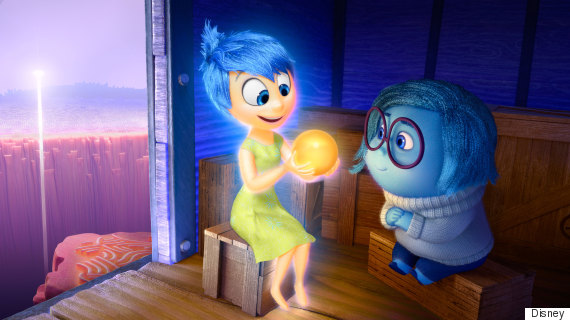
In Pixar's Inside Out, Joy learns the importance of Sadness. Similarly, we need to appreciate failure's crucial role in the learning process, just as Pixar's filmmakers do. Photo: ©Disney
Like most parents this summer, I went to see "Inside Out." Unlike most, I went alone. It was on my oldest son's birthday and I wanted to honor our birthday tradition of going to a family movie, despite the fact my newly minted 21-year-old was 860 miles away playing basketball with his Idaho State University teammates. I started crying as I took my seat, realizing our tradition had run its course since both boys are now ginormous men chasing college hoop dreams.
I had anxiously awaited the release of "Inside Out" since reading Pixar Co-Founder and President Ed Catmull's fascinating book, "Creativity, Inc." His focus is building a creative culture and uses candid examples from Pixar's 20 year history to illustrate the philosophies that nurture and protect the creative process. The book was a gift from my own CEO, another brilliant man so committed to advancing innovation and creativity within his team that he bought a copy for all 198 of his employees, a bold move considering the book devotes 70 pages to the importance of embracing failure.
"Creativity, Inc." uses the making of "Inside Out" to illustrate how honesty and candor -- including criticism -- fuels creativity within Pixar. It was also used to show how many hundreds of iterations a story idea goes through before finally arriving at your local cineplex. Failure was critical to Pixar's development of all their movies and they don't shy away from it, they embrace it. Great message, but at the time, I was far more excited about the actual story concept: an animated movie about "What's inside the mind?" With degrees in education and developmental psychology, and my job at a neuroscience social benefit organization called (wait for it) MIND. It's as if Ed and his pals made the movie just for me.
As everyone who has seen the movie now knows, the mind we go inside belongs to 11-year-old Riley. Like all humans, she is guided by her emotions: Joy, Anger, Disgust, Fear and Sadness. Joy is clearly in charge of Riley as the movie begins and goes to great lengths to keep the other emotions, especially Sadness, far, far away. Eventually, Joy discovers that Sadness plays an important role -- a signal to one's self and others that help is needed in some way, and that the loss of something or someone important has brought us grief. With this new understanding, Joy urges Sadness to take control of Riley's emotions, which in turn helps Riley mend her relationship with her parents. As I left the theater, I embraced my own empty nest-inspired sadness as a small price to pay for the joy of raising two loving, talented young men with the courage to chase their dreams far from home.
And with this simple, beautiful illustration of Joy finally understanding the role of Sadness in "Inside Out," I fully understood the focus on embracing failure within "Creativity Inc." Failure is to learning as Sadness is to Joy. We don't want to spend the majority of our time experiencing failure, but it plays a vital role in our life and our growing understanding of the world around us. And like Joy's attempt at minimizing Sadness, many of us parents minimize our children's risks because we lack understanding of its role in learning, we are robbing our children of the opportunity to fail.
As parents, we don't enjoy seeing our children fail any more than they enjoy experiencing it. Like Joy in "Inside Out," we want to jump in and take control. But our childrenneed to experience failure.
"Mistakes are one of the best learning vehicles," says neuroscientist Matthew Peterson, my CEO who gave his team copies of "Creativity, Inc." "You can learn more from a mistake, often, than from getting something right."
Children need to fail to learn what doesn't work, and then to innovate and create new approaches, new solutions. They need to experience the Joy and Pride of finally solving a tantalizingly tricky problem, and use resulting self-confidence to tackle and embrace future challenges. They need to build persistence and perseverance so that they become adults and future employees who finish what they start, do great work and enjoy themselves in the process.
Children who are not afraid of failure have what psychologists call a growth mindset, which is key to creating lifelong learners who thrive on challenges.
Children learn best when they learn by doing, which naturally involves a lot of failing before mastery. Babies don't learn to walk by attending a lecture series. One day they get curious about what life is like one foot higher above the ground. So, they pull themselves up, take a step and immediately fail. They fail again and again until one day, they stay upright and the feat of walking is accomplished. Kids aren't born afraid of failure; they learn to be afraid of failure, and often they learn it from us.
As parents, we need to invite failure -- and the emotions that come with it -- into our children's lives. It's by working through failure, falling short of the desired goal over and over, experiencing the fear, anger and sadness that they succeed and discover the joy in learning. And on that day, Joy will be clearly in charge once more! But first, we have to embrace and invite failure into their lives.
So, how will you give your child the gift of failure this summer?
MIND Research Institute is a partner of Cisco CSR. Cisco sponsors The Huffington Post's ImpactX section.